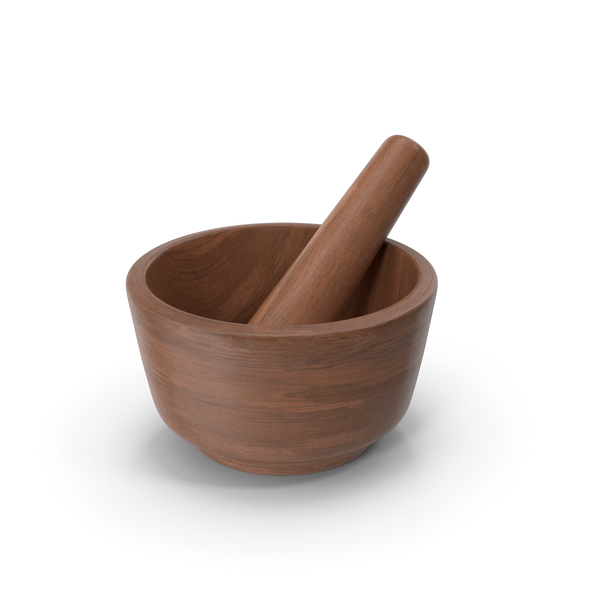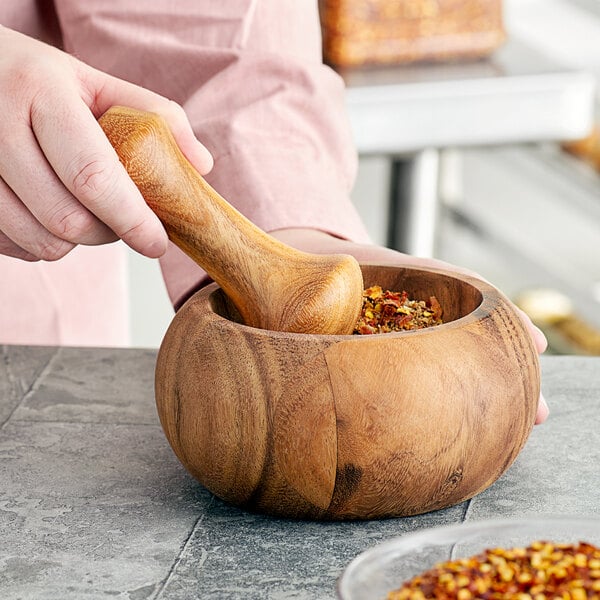If you enjoy working in the kitchen or enjoy watching cooking shows, you have probably already seen a mortar and pestle. But do you know what a mortar and pestle does – or how to use them?
This article will break down all you need to know about how to use this popular kitchen tool.
What is a mortar and pestle?
A mortar and pestle set is basically a small bowl with a stick that resembles a baseball bat. It is used to crush various foods.
Selecting a mortar and pestle
There are several types of mortar and pestles you can choose from, we’ll go over a few of the most popular choices.
Wooden mortar and pestles
These mortar and pestles are commonly used in more laid-back recipes. If you only cook from time to time, you may just want a basic wooden mortar and pestle. Many people prefer these mortar and pestles because they are often affordable and very aesthetically pleasing. However, they may also be functional as well. You can use a wooden mortar and pestle to grind spices with larger grains into a powder.
If you would like a wooden mortar and pestle there are some downsides you should know about. Wood tends to absorb liquids and pigments more than other materials, so it may stain. Wood can also be quite soft, so it may be difficult to achieve finer powders.
Granite Mortar and Pestle
Granite is another popular material for mortar and pestles because they can come in various colors and are often beautiful additions to your kitchen. They are also quite functional as they are hard and have little friction, so they are great at grinding spices of any size into a fine powder.
However, granite mortar and pestles can be a bit pricey. Surprisingly, granite is also absorbent. This means if you use liquids or highly pigmented spices, you may see stains inside your mortar or on your pestle.
Marble Mortar and Pestle
This is perhaps the best option for those who want a beautiful mortar and pestle, as well as a functional one. Marble mortar and pestles offer a hard surface on which to grind your spices. It helps you achieve a finer powder and a smoother grind. Additionally, marble mortar and pestles are resistant to stains and do not absorb any particles from your spices or other foods.
Marble mortar and pestles come in various colors and designs. It makes them aesthetically pleasing and sure to fit into your kitchen decor. However, marble mortar and pestles are also relatively pricey and may not be functional for all of your needs. They are typically very smooth, therefore, some foods and spices may slide when you try to grind them. This may make grinding certain foods or spices particularly difficult.
How to use a mortar and pestle properly
Before you begin using your new mortar and pestle, you should consider what you hope to achieve with this process. For example, do you want to smash a piece of food or grind it? In some cases, such as garlic, you may want to smash the ingredient and produce a more juicy fluid to season your dish. However, in the case of whole black pepper seeds, you may want to grind the seeds into a fine powder to sprinkle on your dish.
Typically, when you want to use your mortar and pestle, you simply place the ingredients you want to grind into your mortar. Then you take your pestle and, using a slight angle, you press the end of your pestle into the ingredient. Grind in small circular motions. Hold your pestle by grabbing the base of the pestle in much the same way you would grab a baseball bat, with the end of the pestle resting in the mortar. Add the ingredient you wish to grind into the mortar until the mortar is about a third to halfway full.
When you begin grinding, you should pick up the mortar and hold it comfortably against your abdomen or waist. This positioning should give you the appropriate leverage to use as much force as possible, while also allowing you to comfortably use your mortar and pestle for prolonged grinding.
If you want your mortar and pestle to produce a more mushy, liquid product, you should use a lighter force when grinding. So, if the natural juices of the ingredient are not enough, simply add a teaspoon of water at a time until you achieve the consistency that you want.
If you desire a finer powder, you should use a harder force. Then, prepare to grind for a longer period. To achieve a powder, you should also remember to use dry or dehydrated ingredients. It is to prevent moisture from accumulating in your powder.
Intermittently check in on your ingredients to observe if you have reached your desired consistency. After you have completed grinding for some time, empty the contents of your mortar into a small bowl. As mortars are not mechanical in nature, the consistency of your grind may not have been ideal. To remove larger grains or chunks from your ingredient, simply pass it through a sift of your required grain size. Then, place the filtered contents back into the mortar to be ground again.
Preparing a mortar for use
It is important to remember that most mortars are not prepared to be used immediately after purchase.
They need to be seasoned before they can be safely used to grind your food. This is because most mortar and pestles, although they may be made from strong materials, need time to adjust to their function.
The first time they are used to grind a substance, particles from inside them may detach and enter the food. After their first grind, this should no longer happen.
You want to begin seasoning your mortar and pestle by rinsing them.
Then simply add a product that you will grind. Plain white rice is easy to obtain and spot foreign particles.
Grind the product as described above, then empty the contents and grind again. Repeat until the ground rice no longer contains particles from your mortar and pestle.
Katy Willis is a writer, lifelong homesteader, and master herbalist, master gardener, and canine nutritionist. Katy is a preparedness expert and modern homesteader practicing everyday preparedness, sustainability, and a holistic lifestyle.
She knows how important it is to be prepared for whatever life throws at you, because you just never know what's coming. And preparedness helps you give your family the best chance to thrive in any situation.
Katy is passionate about living naturally, growing food, keeping livestock, foraging, and making and using herbal remedies. Katy is an experienced herbalist and a member of the CMA (Complementary Medical Association).
Her preparedness skills go beyond just being "ready", she's ready to survive the initial disaster, and thrive afterward, too. She grows 100% organic food on roughly 15 acres and raises goats, chickens, and ducks. She also lovingly tends her orchard, where she grows many different fruit trees. And, because she likes to know exactly what she's feeding her family, she's a seasoned from-scratch cook and gluten-free baker.
Katy teaches foraging and environmental education classes, too, including self-sufficient living, modern homesteading, seed saving, and organic vegetable gardening.
Katy helps others learn forgotten skills, including basic survival skills and self-reliance.
She's been published on sites such as MSN, Angi, Home Advisor, Family Handyman, Wealth of Geeks, Readers Digest, and more.


